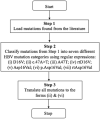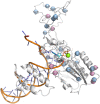Understanding the genetics of viral drug resistance by integrating clinical data and mining of the scientific literature
- PMID: 36008431
- PMCID: PMC9403226
- DOI: 10.1038/s41598-022-17746-3
Understanding the genetics of viral drug resistance by integrating clinical data and mining of the scientific literature
Abstract
Drug resistance caused by mutations is a public health threat for existing and emerging viral diseases. A wealth of evidence about these mutations and their clinically associated phenotypes is scattered across the literature, but a comprehensive perspective is usually lacking. This work aimed to produce a clinically relevant view for the case of Hepatitis B virus (HBV) mutations by combining a chronic HBV clinical study with a compendium of genetic mutations systematically gathered from the scientific literature. We enriched clinical mutation data by systematically mining 2,472,725 scientific articles from PubMed Central in order to gather information about the HBV mutational landscape. By performing this analysis, we were able to identify mutational hotspots for each HBV genotype (A-E) and gene (C, X, P, S), as well as the location of disulfide bonds associated with these mutations. Through a modelling study, we also identified a mutation position common in both the clinical data and the literature that is located at the binding pocket for a known anti-HBV drug, namely entecavir. The results of this novel approach show the potential of integrated analyses to assist in the development of new drugs for viral diseases that are more robust to resistance. Such analyses should be of particular interest due to the increasing importance of viral resistance in established and emerging viruses, such as for newly developed drugs against SARS-CoV-2.
© 2022. The Author(s).
Conflict of interest statement
The authors declare no competing interests.
Figures








References
-
- World Health Organization. Hepatitis B. World Health Organizationhttps://www.who.int/en/news-room/fact-sheets/detail/hepatitis-b (2019).
-
- Spradling P, Hu D, McMahon BJ, et al. Epidemiology and prevention. In: Thomas H, et al., editors. Viral Hepatitis. Wiley; 2013.
Publication types
MeSH terms
Substances
LinkOut - more resources
Full Text Sources
Miscellaneous

